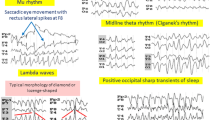Abstract
Continuous recordings were made of slow potential shift activity occurring at six locations on the surface of the cerebral cortex of seizure-prone and non seizure-prone gerbils. Measurements were made for 80-s epochs of recordings of frequency, maximum and minimum slow shift amplitude and baseline potential of the brain during periods of normal inactivity and subsequently during halothane anaesthesia. Induction of anaesthesia initially provoked large (millivolt) slow (3–4 s) oscillations in all animals, larger in amplitude than any recorded prior to anaesthesia. With increasing depth of anaesthesia, all animals also showed a reduction in the amplitude of this spontaneous slow potential shift activity. The effect was most pronounced in seizure-prone animals, and subsequent to anaesthetic-induced behavioural immobility, these animals also showed a regional resistance to the depression of spontaneous slow potential shift oscillations. Slow potential shift activity during anaesthesia represents ionic fluxes which may normally be involved in modulation of neuronal responsiveness. It was suggested that glia may be targets for anaesthetics and that seizure susceptibility may confer some degree of resistance to the depressant effects of such substances.
Similar content being viewed by others
Author information
Authors and Affiliations
Additional information
Accepted: 25 January 1998
Rights and permissions
About this article
Cite this article
Roughan, J., Laming, P. Large slow potential shifts occur during halothane anaesthesia in gerbils. J Comp Physiol A 182, 839–848 (1998). https://doi.org/10.1007/s003590050228
Issue Date:
DOI: https://doi.org/10.1007/s003590050228




